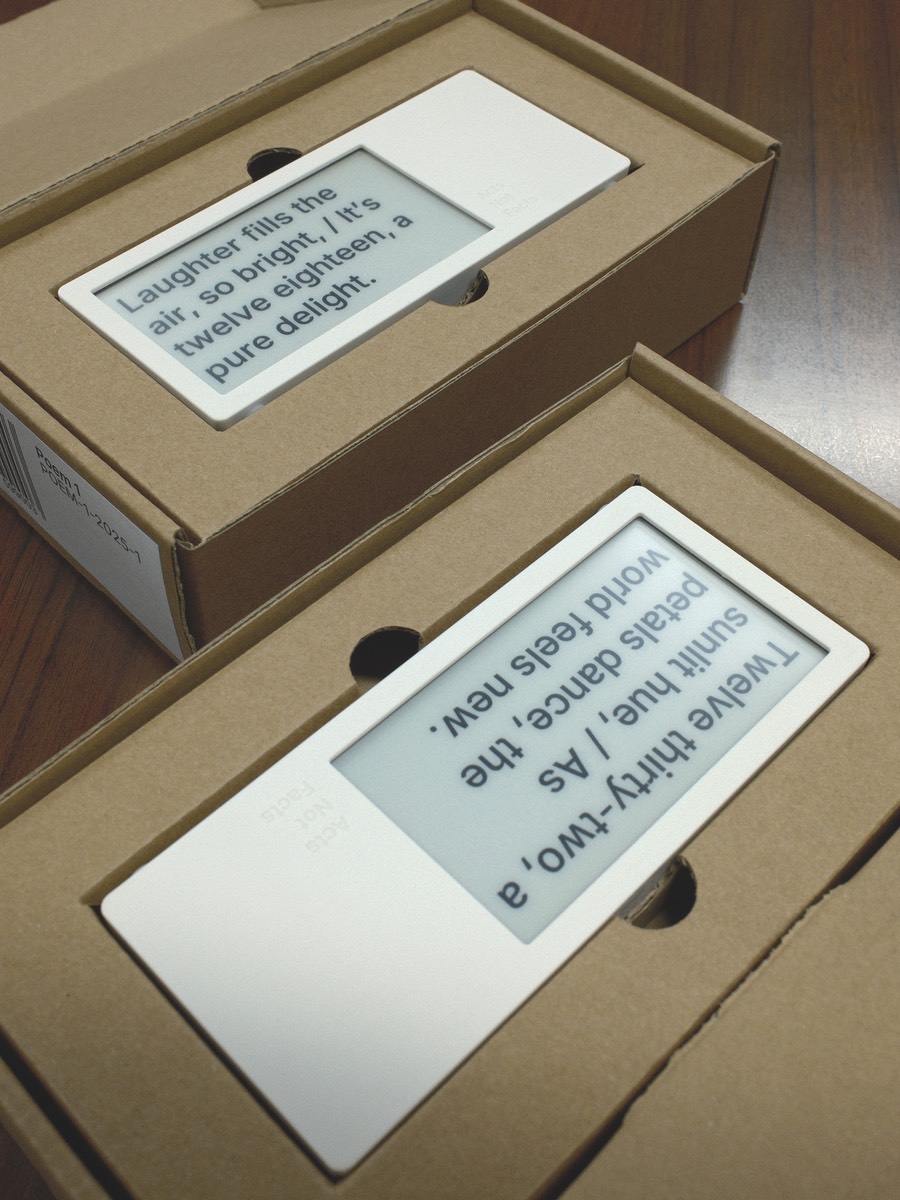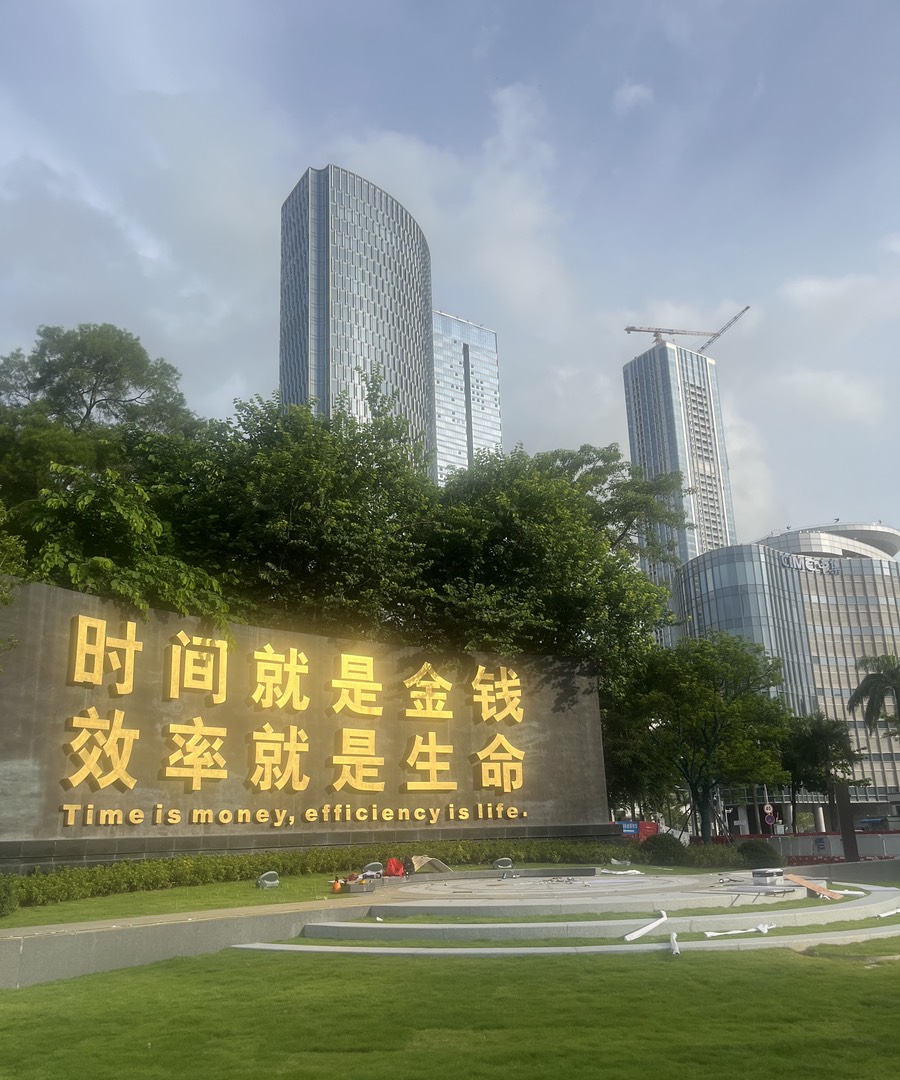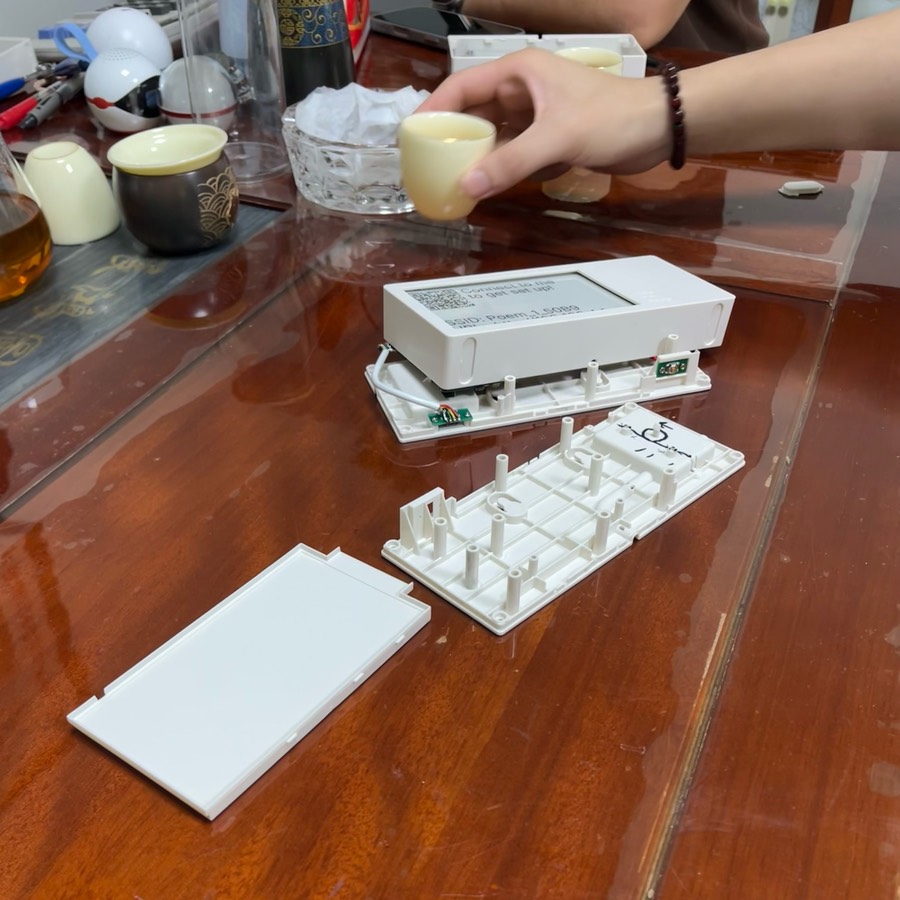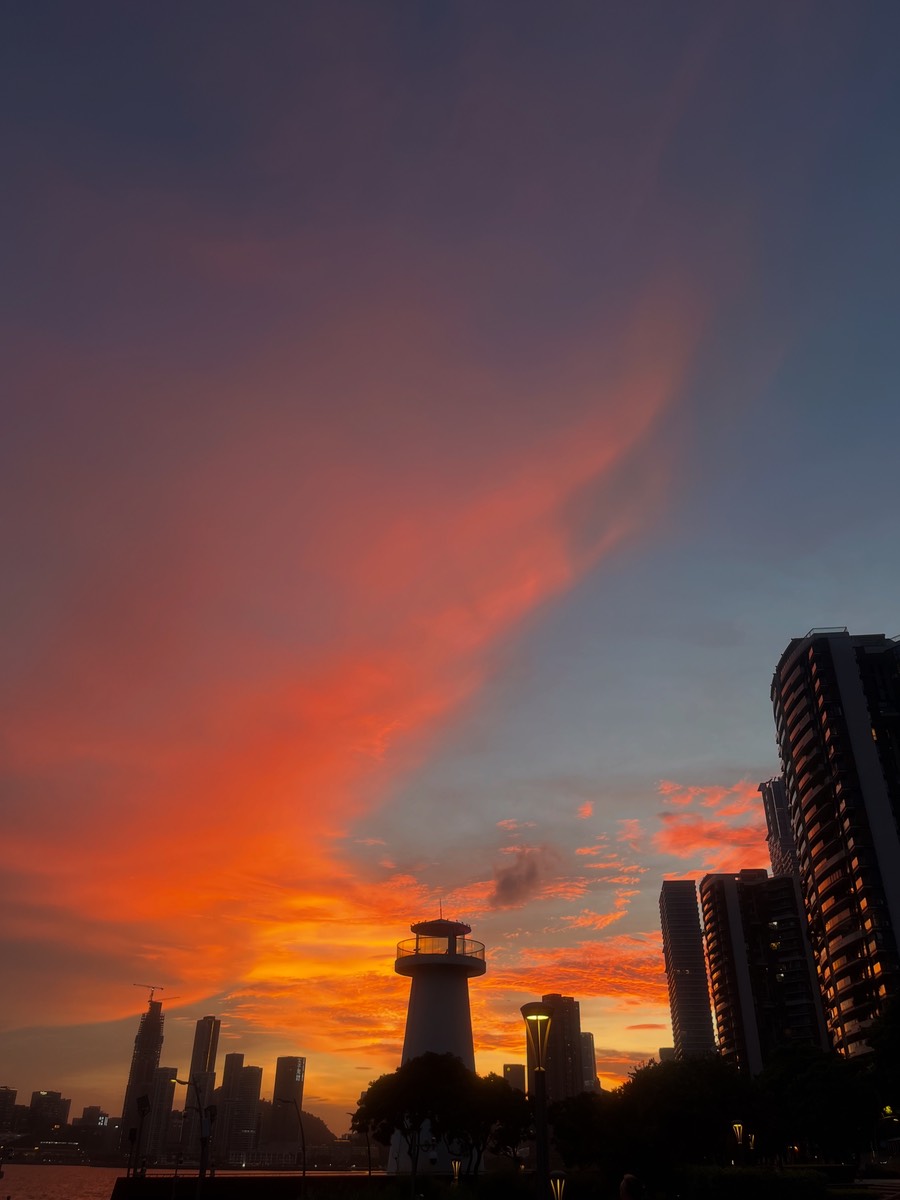I’ve been in Shenzhen the last few days visiting factories and suppliers for my Poem/1 AI clock.
Remember that clock?
It tells the time with a new rhyming couplet every minute. A half million poems per year which I believe is the highest poem velocity of any consumer gadget. (Do correct me if I’m wrong.)
I made a prototype, it went viral and ended up in the New York Times. So I ran a successful Kickstarter. Then - as is traditional - ran into some wild electronics hurdles involving a less-than-honest supplier… Kickstarter backers will know the story from the backers-only posts. (Thank you for your support, and thank you for your patience.)
So somehow I’ve become an AI hardware person? There can’t be many of us.
ANYWAY.
Poem/1 is now heading towards pilot production.
Here are the two VERY FIRST pieces hot off the test assembly line!

What a milestone.
Next up… oh about a thousand things haha
Like: a case iteration to tighten fit and dial in the colour, and an aging test to check that a concerning display damage risk is fixed. Pilot production is 100 units, allocated for certification and end-to-end tests from the warehouse in Hong Kong… Plus some firmware changes to fit better with the assembly line, and, and, and… I can handle all from London over the next few weeks.
It was my first visit to Shenzhen and actually my first to mainland China.
This motto is everywhere:

Time is money, efficiency is life.
It’s a quote from Yuan Geng, director of the Shekou Industrial Zone which is where China’s opening up began in 1979.
Shekou is a neighbourhood in Shenzhen (I stayed there in a gorgeous B&B-style hotel). According to the leaflet I picked up, Shenzhen now has 17.8 million permanent residents (as of end 2023) with an average age of 32.5.
“My” factory is in Liaobu town, Dongguan, 90 minutes north. (It’s shared, of course, the line spins up and spins down as needed.)
Dongguan has 10.5m residents (for comparison, London is 8.8m) and is divided into townships, each of which specialises in a different area of industrial production, for instance textiles or plastic injection moulding.
Driving around meeting with various suppliers (there’s a supply chain even for a product this simple), I noticed that the factories were often small and independently owned.
So when we meet the manager, they’re often an ex engineer, with deep domain skills and experience. Issues can be analysed and resolved there and then.

This is a photo from the injection moulding factory, discussing the next iteration of the tool.
The manager’s office has a desk with a computer and files, with one chair, and a second tea table for discussion. This is a wooden desk with built-in tea making facilities.
We shared the marked-up test pieces (you see the marker pen drawing? Other plastic pieces were more annotated) and talked over constraints and trade-offs: the mechanical nature of the tool, quality/aesthetics, assembly line efficiency, risk mitigation e.g. the display problem I mentioned earlier which comes (we think) from a stressed ribbon cable bond that weakens from vibration during shipping.
Then: decisions and maybe a tour of the floor, and then we head off.
It was an amazingly productive trip.
And just… enjoyable. Sitting in the factory conference room, reviewing parts, eating lychees…
The “general intellect” in the region (to use Marx’s term for social knowledge) is astounding, and that’s even before I get to the density of suppliers and sophistication of machinery and automation.
Factory managers are immersed in a culture of both product and production, so beyond the immediate role they are also asking smart questions about strategy, say.
And in one case, it was such a privilege to be walked through a modern assembly line and get a breakdown of their line management system – shown with deserved pride.
I have so many stories!
Also from visiting the electronics markets (8 city blocks downtown), and generally being out and about…
That can all wait till another time.

For now – I’m settling back into London and reviewing a colossal to-do list.
And remembering an oh so hot and oh so humid sunset run in Shekou.
Beautiful.
Are you interested in Poem/1 but missed the Kickstarter?
Join the Poem/1 newsletter on Substack.
It has been dormant for a year+ but I’ll be warming it up again soon now that (fingers crossed) I can see mass production approaching.
I’ll be opening an online store after fulfilling my wonderful Kickstarter backers, and that newsletter is where you’ll hear about it first.
I’ve been in Shenzhen the last few days visiting factories and suppliers for my Poem/1 AI clock.
Remember that clock?
It tells the time with a new rhyming couplet every minute. A half million poems per year which I believe is the highest poem velocity of any consumer gadget. (Do correct me if I’m wrong.)
I made a prototype, it went viral and ended up in the New York Times. So I ran a successful Kickstarter. Then - as is traditional - ran into some wild electronics hurdles involving a less-than-honest supplier… Kickstarter backers will know the story from the backers-only posts. (Thank you for your support, and thank you for your patience.)
So somehow I’ve become an AI hardware person? There can’t be many of us.
ANYWAY.
Poem/1 is now heading towards pilot production.
Here are the two VERY FIRST pieces hot off the test assembly line!
What a milestone.
Next up… oh about a thousand things haha
Like: a case iteration to tighten fit and dial in the colour, and an aging test to check that a concerning display damage risk is fixed. Pilot production is 100 units, allocated for certification and end-to-end tests from the warehouse in Hong Kong… Plus some firmware changes to fit better with the assembly line, and, and, and… I can handle all from London over the next few weeks.
It was my first visit to Shenzhen and actually my first to mainland China.
This motto is everywhere:
It’s a quote from Yuan Geng, director of the Shekou Industrial Zone which is where China’s opening up began in 1979.
Shekou is a neighbourhood in Shenzhen (I stayed there in a gorgeous B&B-style hotel). According to the leaflet I picked up, Shenzhen now has 17.8 million permanent residents (as of end 2023) with an average age of 32.5.
“My” factory is in Liaobu town, Dongguan, 90 minutes north. (It’s shared, of course, the line spins up and spins down as needed.)
Dongguan has 10.5m residents (for comparison, London is 8.8m) and is divided into townships, each of which specialises in a different area of industrial production, for instance textiles or plastic injection moulding.
Driving around meeting with various suppliers (there’s a supply chain even for a product this simple), I noticed that the factories were often small and independently owned.
So when we meet the manager, they’re often an ex engineer, with deep domain skills and experience. Issues can be analysed and resolved there and then.
This is a photo from the injection moulding factory, discussing the next iteration of the tool.
The manager’s office has a desk with a computer and files, with one chair, and a second tea table for discussion. This is a wooden desk with built-in tea making facilities.
We shared the marked-up test pieces (you see the marker pen drawing? Other plastic pieces were more annotated) and talked over constraints and trade-offs: the mechanical nature of the tool, quality/aesthetics, assembly line efficiency, risk mitigation e.g. the display problem I mentioned earlier which comes (we think) from a stressed ribbon cable bond that weakens from vibration during shipping.
Then: decisions and maybe a tour of the floor, and then we head off.
It was an amazingly productive trip.
And just… enjoyable. Sitting in the factory conference room, reviewing parts, eating lychees…
The “general intellect” in the region (to use Marx’s term for social knowledge) is astounding, and that’s even before I get to the density of suppliers and sophistication of machinery and automation.
Factory managers are immersed in a culture of both product and production, so beyond the immediate role they are also asking smart questions about strategy, say.
And in one case, it was such a privilege to be walked through a modern assembly line and get a breakdown of their line management system – shown with deserved pride.
I have so many stories!
Also from visiting the electronics markets (8 city blocks downtown), and generally being out and about…
That can all wait till another time.
For now – I’m settling back into London and reviewing a colossal to-do list.
And remembering an oh so hot and oh so humid sunset run in Shekou.
Beautiful.
Are you interested in Poem/1 but missed the Kickstarter?
Join the Poem/1 newsletter on Substack.
It has been dormant for a year+ but I’ll be warming it up again soon now that (fingers crossed) I can see mass production approaching.
I’ll be opening an online store after fulfilling my wonderful Kickstarter backers, and that newsletter is where you’ll hear about it first.